How to Improve Your Dolphin Kick
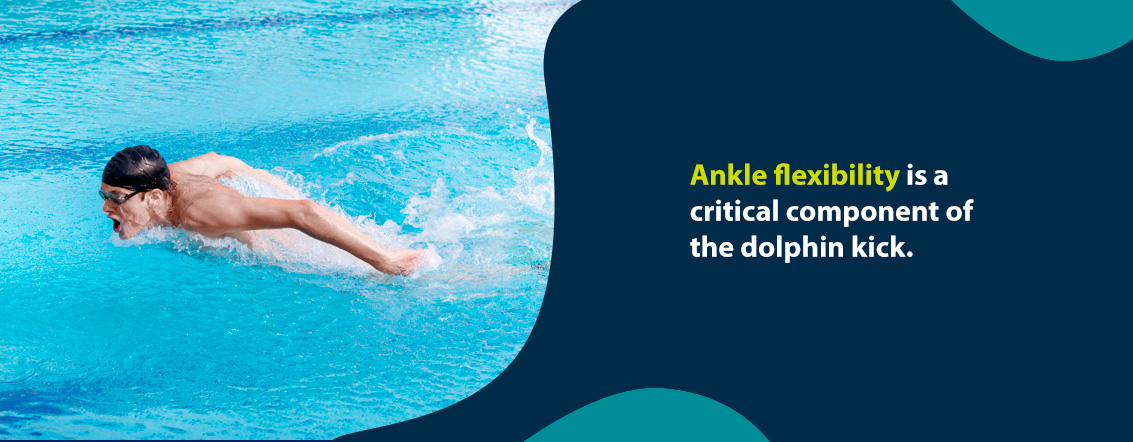
Kiefer News
|
October 24, 2022
How to Improve Your Dolphin Kick
Underwater dolphin kicks are a mighty tool in any swimmer's arsenal. Powerful underwaters can turn swimmers into swimming legends who can shoot 15 meters underwater before even breaking into their stroke. Seeing the edge this stroke gives champions like Michael Phelps, Tom Shields, Sarah Sjöström or Zhang Yufei inspires many athletes to hit the pool and try dolphin kick training. However, after exhausting yourself with practice and discovering that you're much slower than you'd hoped, the desire for proper technique floats away and is forgotten until the next championship rolls around. Improving your underwater dolphin kick is all about mastering good form and proper technique. How? In this article, we'll break down the elements of the dolphin kick and its role in the world of swimming today. Once we've covered the basics, we'll dive into the various strategies you can implement to transform a flimsy underwater flop into a powerful surge through the water.What Is a Dolphin Kick?
The dolphin kick is an underwater maneuver that mimics the motion of — you guessed it — a dolphin. A dolphin's undulations propel it through the water at incredible speeds while costing very little energy expenditure in the process. This high-speed, high-efficiency propulsion is due to the powerful downstroke of the dolphin's tail as well as its streamlined, drag-resistant shape. Without a powerful fluke or naturally aerodynamic body, swimmers looking to recreate a dolphin's kick need to simulate two things — muscle power and streamlining. The result is the dolphin kick swimmers use today. To create the streamlined posture required for the dolphin kick, place one hand on top of the other and wrap the top thumb around both hands to squeeze them together. This action ensures that your arms, once extended, stay fixed to the sides of your head. Next, extend the arms up so that they're in line with your ears with both biceps touching the tops of your ears. Squeeze your inner arms tightly to your head so no room between your arms and your neck or head remains. Then, make your body as flat as possible, pulling in the rib cage, belly button and glutes to ensure there's no arch in your lower back. Lastly, after pushing off the wall, keep your legs tight together, resisting the urge to splay them in order to find balance. The tighter you can maintain this streamlined posture, the farther you can glide underwater.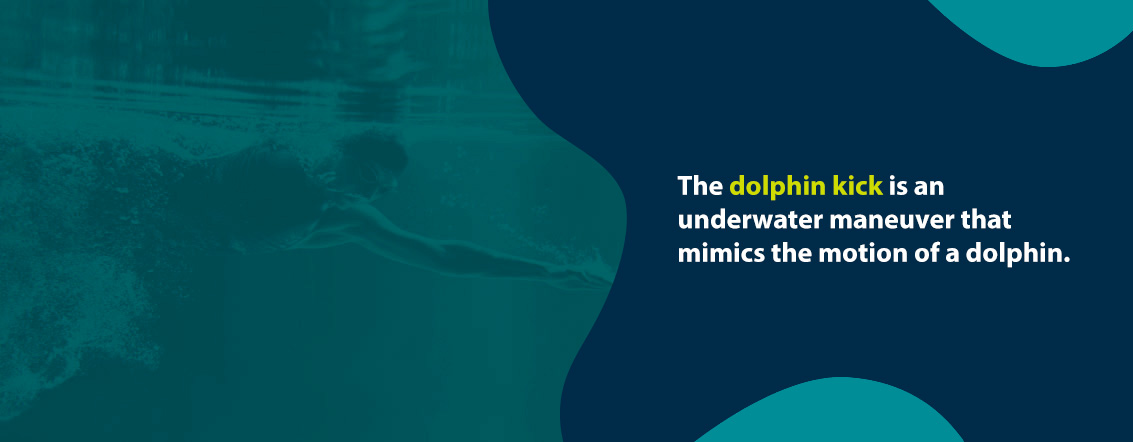 Once you've initiated the glide, it's time to add some power. The kick's strength comes from your quads and two-directional kicking, resulting in three phases of a dolphin kick — the forward kick, the transition and the back kick. As you begin, engage your core to initiate the forward kick. Next, you'll move into the transition phase with your legs and knees fully extended. From this position, engage the back kick, which adds some propulsion and primarily repositions your feet to drive down once more for the forward kick. When blended together, these phases will be fluid and create a whip-like undulation.
Once you've initiated the glide, it's time to add some power. The kick's strength comes from your quads and two-directional kicking, resulting in three phases of a dolphin kick — the forward kick, the transition and the back kick. As you begin, engage your core to initiate the forward kick. Next, you'll move into the transition phase with your legs and knees fully extended. From this position, engage the back kick, which adds some propulsion and primarily repositions your feet to drive down once more for the forward kick. When blended together, these phases will be fluid and create a whip-like undulation.
History of the Dolphin Kick
For many years, the dolphin kick was not as widely used as it is today — until American swimmer Jesse Vassallo began using two or three kicks on his starts and turns in order to avoid the waves of larger swimmers and stabilize his body before the strokes. In the 80s, Japanese backstroker Daichi Suzuki tried something similar for farther distances. The real paradigm shift occurred when Stanford swimmers Jay Mortensen and Sean Murphy noticed a female swimmer utilizing the dolphin kick in elite competitions in order to minimize the use of an injured shoulder. They were inspired and took the dolphin to an NCAA event where Mortensen broke records and placed second, with Murphy placing third. Things really took off when David Berkoff began adding underwaters to his races. With these strokes, he set world records in the 100 backstroke, starting races underwater for 35 meters. These starts were so astounding that announcers started calling them the "Berkoff Blastoff," a name used to refer to underwater dolphin kicks for decades. That's when swimmers everywhere began incorporating underwaters into their races. At the 1988 Olympic Games, five of the eight 100 meter backstroke swimmers went 20 meters underwater before breaking into their strokes. FINA, swimming's governing body, began regulating how far swimmers could use the dolphin kick in their races, while coaches and swimmers remained skeptical about its effectiveness. It took many years for athletes to take full advantage of the 15 meters that the FINA permitted for underwaters at the start of a race. Once swimmer Neil Walker mastered using the kick for 15 meters in the backstroke and subsequently beat an Olympian gold-medalist, the swimming community gave the dolphin stroke another shot. Then, Misty Hyman brought the kick into the turns in her butterfly stroke and beat a gold medalist in a race of her own. The rest was history. Today, swimming's greatest athletes have won medals using this method, with swimmers everywhere investing their time into mastering this sport-changing kick.How to Improve Your Underwater Dolphin Kick
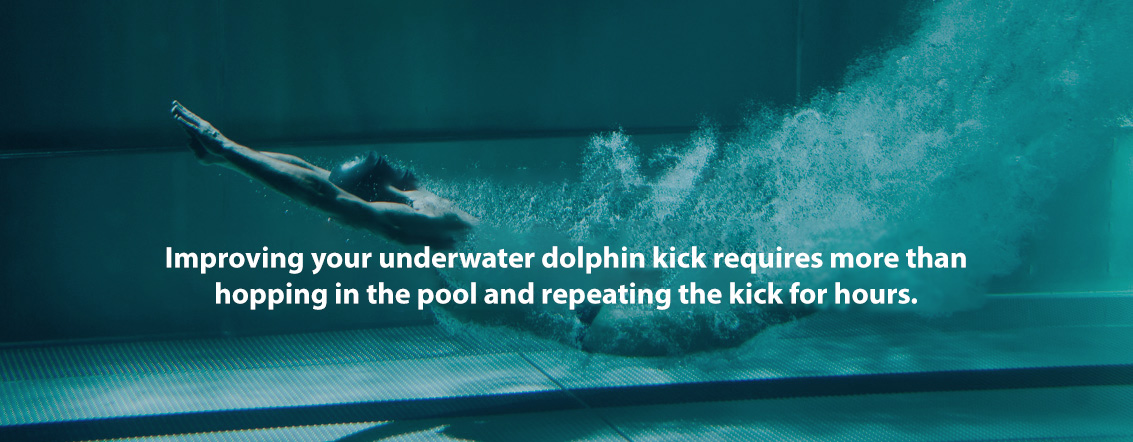 Improving your underwater dolphin kick requires more than hopping in the pool and repeating the kick for hours. You'll just clock a lot of hours doing the same technique that hasn't been serving your speed. Several moving pieces make this maneuver such an asset in a race, and fine-tuning those pieces individually is the best way to boost your underwaters. You'll also want to strengthen the muscles and ligaments that power your dolphin stroke for maximum performance.
It's important not to get greedy with your gains as you undergo this process. Expecting to see maximal changes right away is unrealistic. Instead, opt for a slow and steady mindset, congratulating yourself for marginal improvements that will add up. Here's how to start seeing those little victories in your kick.
Improving your underwater dolphin kick requires more than hopping in the pool and repeating the kick for hours. You'll just clock a lot of hours doing the same technique that hasn't been serving your speed. Several moving pieces make this maneuver such an asset in a race, and fine-tuning those pieces individually is the best way to boost your underwaters. You'll also want to strengthen the muscles and ligaments that power your dolphin stroke for maximum performance.
It's important not to get greedy with your gains as you undergo this process. Expecting to see maximal changes right away is unrealistic. Instead, opt for a slow and steady mindset, congratulating yourself for marginal improvements that will add up. Here's how to start seeing those little victories in your kick.
Release the Need for Speed
One of the simplest tricks we can teach you is to release the need for speed. The fastest you'll ever be in a race is when diving in or pushing off the wall. One of the most misunderstood secrets about utilizing the dolphin kick is that no kick or stroke can make you go any faster than that initial burst of speed. Those first 15 meters aren't so much about going faster as stretching your starting speed for as long as you possibly can before surging into your stroke. As you begin to improve your underwaters, don't get stuck too early on improving your time. Focus more on improving your form.Watch Your Knees
One of the tricky parts of mastering the dolphin kick is making sure your kicks aren't too small or too big. A small kick won't generate enough power, but a big kick can cause your legs to bend out of your body line or body vortex and create drag. It's all about finding the sweet spot for your individual height and proportions. To look at this sort of tinkering in action, look no further than this study conducted on the dolphin kick of Olympic swimmer Marcus Schlesinger. After recording the velocity and movement throughout Schlesinger's kick, Dr. Gary Hall, a former Olympian, critiqued the strengths and weaknesses of his technique. One of his main notes for improvement was the bend in Schlesinger's knee. Dr. Hall compared the angle to competitive swimmer Kelsi Dahlia's, describing how her ability to bend her knees within her body's vortex was how she was able to get four points of acceleration in the kick, whereas Schlesinger only managed two. Flexibility plays a substantial role in finessing this sort of alignment.Drive Through Your Hips and Core
If you're relying on your knees to create your kick, you're never going to see the improvements you're aiming for. In order for the knees to create the whip-like movement on their own, they'll have to pump up and down more than they should, creating drag and causing the problem we just described above. Overcompensating with the knees points to the underuse of a much more important group of muscles — the ones in your hips and core. Engaging more of your body in the kick will give you more bang for your buck power-wise while also correcting any poor techniques resulting from over-angled knees. This is where ab workouts and squats become your best friend. If you treat your core like a power plant, you'll see remarkable gains.Mind Your Feet (and Treat Them Like a Fluke)
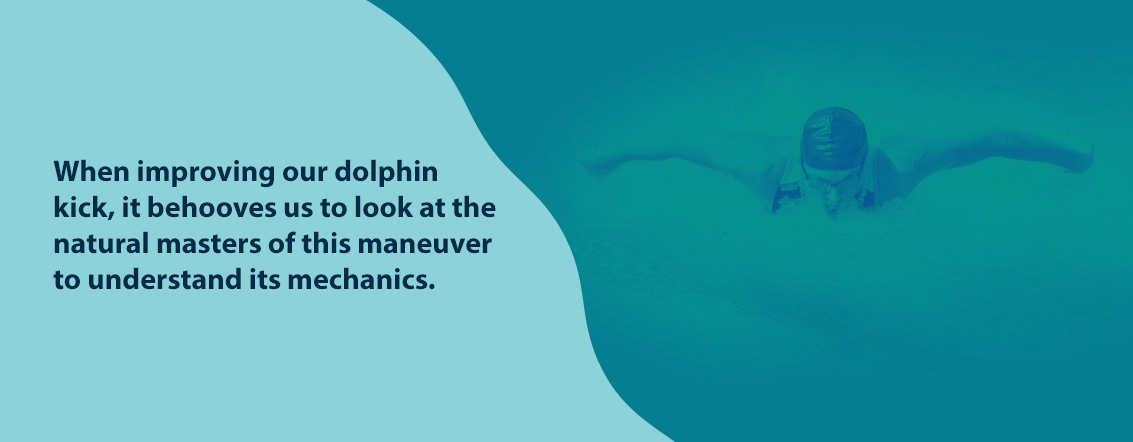 When improving our dolphin kick, it behooves us to look at the natural masters of this maneuver to understand its mechanics. If you look at a dolphin as it swims, notice how it pulls up its tail to push the water down and away from its body, creating propulsion. The animal isn't just flapping its fluke up and down but rather driving water away with strength. Imagine your feet fusing together at the toes to form a fluke. Then think of pushing the water out and away from your body.
Remember that though the energy comes from your hips, thighs and knees, it's your feet that are actually moving you through the water, so you'll want to develop the flexibility to use them to their full potential. Dolphin flukes have a lot of flat surface area with which to push the water. Swimmers replicate this with their feet by fostering early vertical ankles. The more flexible your ankles are, the further they can stretch back through the kick, resulting in more surface area on the tops of your feet that you can use to move water behind you.
When improving our dolphin kick, it behooves us to look at the natural masters of this maneuver to understand its mechanics. If you look at a dolphin as it swims, notice how it pulls up its tail to push the water down and away from its body, creating propulsion. The animal isn't just flapping its fluke up and down but rather driving water away with strength. Imagine your feet fusing together at the toes to form a fluke. Then think of pushing the water out and away from your body.
Remember that though the energy comes from your hips, thighs and knees, it's your feet that are actually moving you through the water, so you'll want to develop the flexibility to use them to their full potential. Dolphin flukes have a lot of flat surface area with which to push the water. Swimmers replicate this with their feet by fostering early vertical ankles. The more flexible your ankles are, the further they can stretch back through the kick, resulting in more surface area on the tops of your feet that you can use to move water behind you.
Increase Ankle Flexibility
As mentioned above, ankle flexibility is a critical component of the dolphin kick. One study conducted on competitive swimmers demonstrated that ankle flexibility corresponded both to speed and velocity in the athletes' performances. Two of our tips already stated their case for ankle flexibility and how much its implementation can help you improve your performance. Remember, the less pliable your ankles are, the more you'll have to bend your knees, which is problematic for speed because that flexibility enables you to get the proper propulsion on the forward kick. If you're unsure of how one exactly strengthens their ankles — other than slogging around with ankle weights all day — we understand. We've collected some dryland and water workouts for you to try.Workouts for Increasing Ankle Flexibility
 For these workouts, you'll need a few pieces of equipment — a jump rope, an exercise band, an angled platform, kickboard and fins. Here's how you can use them to improve your ankle strength and flexibility:
For these workouts, you'll need a few pieces of equipment — a jump rope, an exercise band, an angled platform, kickboard and fins. Here's how you can use them to improve your ankle strength and flexibility:
- Skip rope: Skipping rope is an excellent, low-impact way to strengthen your ankles and improve your cardiovascular capacity and body coordination. Try skipping in intervals starting at five minutes, then 10, then 15 and so on.
- Plantar flexion: Wrap your exercise band around the top of your foot. Sit in a hamstring stretch position and point your toes. Do 15 to 20 reps per side.
- Dorsiflexion: Strap your band to something stable, such as a door frame, then situate the free loop so it rests on the top part of your foot, close to your toes. Pull the top of your foot towards you. Do 15 to 20 reps per side.
- Inversion: Wrap the band around your foot, and with resistance, twist your foot inwards. Do 15 to 20 reps per side.
- Eversion: This exercise is is just like inversion, only now you'll rotate your foot outwards. Do 15 to 20 reps per side.
- Downward toe points: Break out your angled platform and stand on it with your toes facing down, heels elevated off the ground. Then reach down and try to touch your toes. Hold for 15 seconds and then release. Do three to five reps, relaxing the stretch in between.
- Upward toe points: Now do the opposite on the platform — stand on it with your toes facing up this time, heels resting on the ground. Then reach down and try to touch your toes. If you want to add another level to the stretch, try pulling your toes gently upward. Hold for 15 seconds and then release. Do three to five reps, relaxing the stretch in between.




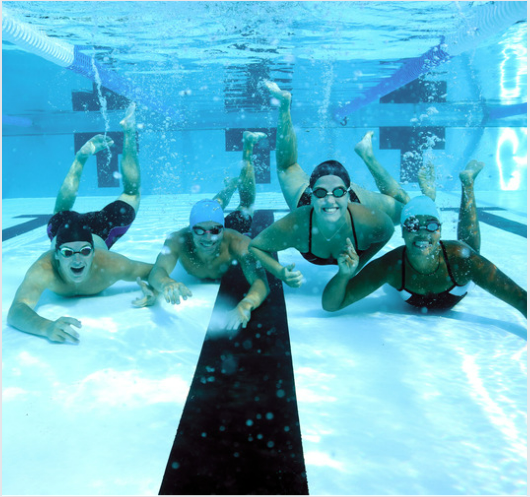


Leave a Comment
Your email address will not be published. Required fields are marked *